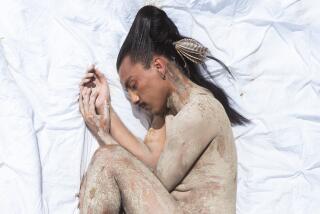Pressure to Look Perfect in Iran
- Share via
TEHRAN — Along this capital’s best boulevards, some young women go about their days in distinctive style: They cover their hair with silk, drape their torsos with smartly cut wraps and, with some aplomb, maneuver the streets peering through layers of white gauze on their faces.
They are part of a nose job nation.
Black-shrouded matrons are still the backbone of Iranian society. But in increasing numbers and at young ages, Iranians are altering their bodies in the pursuit of beauty.
“It’s very common in our society,” said Zahra Kalantar, 18, her body swathed in heavy black robes and her nose in gauze. Her father paid $1,200 for her surgery.
“I really didn’t want to have a nose job, but there was a lot of pressure,” Kalantar said. “My classmates made fun of my nose. So did my cousins.... My nose was big and wide. And here, appearances matter.”
Plastic surgery is common elsewhere, but patients in Iran exude a remarkable enthusiasm about their decision. Bandages are worn openly and youngsters routinely discuss the benefits of looking like Nicole Kidman or Angelina Jolie.
Rhinoplasty has become a common reward for passing college entrance exams. Some people even undergo surgery two or three times -- at a fraction of the cost of Western procedures -- to perfect their profiles framed by the ever-present hijabs, or scarves, they must wear.
The sculpting doesn’t stop there. Chins are filled out. Older women have eye-, breast- and face lifts, surgeons say, and even men are being persuaded to make some changes.
“When I was studying this in college, I wasn’t even thinking about this kind of future,” said plastic surgeon Dabeer Zadeh, 57, whose practice has doubled in the last eight years. “Before the revolution, there were maybe 10 or 20 plastic surgeons in Iran. Now there are many times that.”
Beauty has always been highly valued in Persian culture. “Kill me, but make me beautiful” is a proverb here as well as a refrain in beauty salons, where body waxing is a monthly ritual.
But Zadeh surmises, from conversations with patients, that the 1979 Islamic Revolution played an ironic role in the surge of surgeries.
Iran’s Islamic law demands that women keep their hair, arms and legs covered in public. The revolution, however, also allowed girls better and more extensive higher education. These girls are more open to cultural change even if they are somewhat restricted by the scarves and cover-ups they must wear.
Many of them focus on whatever bit of flesh they can flash. Satellite television beamed in from Farsi-language stations in Los Angeles suggests makeup styles from the West; shows such as “Friends” and “Oprah” are on-screen galleries for nose, cheek and chin possibilities.
“I think it all comes down to the hijab and satellite TV,” said Zadeh, whose waiting room was packed. “The girls focus on what can be seen. Satellite TV shows them what they could be.”
It is difficult to assess the scope of the trend; no government agency appears to track the frequency of the surgeries. But some doctors estimate that tens of thousands of people in this country of 68 million had nose jobs last year. Iran’s Health Ministry recently initiated a campaign to warn patients to use only physicians certified to perform the operation.
It is common to stroll along avenues in tony, northern Tehran and see someone bearing a telltale nose bandage. Documentary filmmaker Mehrdad Oskouei explored the phenomenon. He found that girls and boys, no matter the class or family background, saw nose jobs as necessary. There was nothing un-Islamic about changing their looks, they said. They wanted to fit an image of beauty that appealed to them and seemed beyond the borders of Iran.
“It’s not normal,” the 37-year-old filmmaker said about the proliferation of plastic surgeries, and nose jobs in particular. “I’m from the war generation. In the Iran-Iraq war, people lost an arm or a leg and it was considered an honor. They were losing something for their country. They were attractive for their beliefs.
“Now girls, and increasingly boys, are giving up part of the body -- their face and, as I see it, their identity -- for something else. My question is: How did young people change so drastically? ... What is happening in our society that some of our young people are so empty?”
The women at Mehri’s Salon, a small beauty parlor in northwest Tehran, say they wonder too. Women now wear so much eyeliner, powder and rouge that it seems like a kind of rebellion, said Makrokh Amirshahi, 36, the mother of a teenage daughter.
“These days women don’t wear a little bit of makeup. They’re putting it on. Look at my daughter,” she said, pointing to a photo of the girl with kohl-rimmed eyes and lipstick. “I never did that at my age.”
Amirshahi said she feels pressure to look her best as she nears middle age.
“I’ve thought about getting a nose job,” she said. “But every time I get ready to go to the doctor, I hear of somebody who had a problem.
“Last night my daughter told me in other countries people aren’t focused so much on themselves.... But we come to the salon and we sit for hours. Here, we don’t have any other entertainment than ourselves.”
More to Read
Sign up for Essential California
The most important California stories and recommendations in your inbox every morning.
You may occasionally receive promotional content from the Los Angeles Times.










